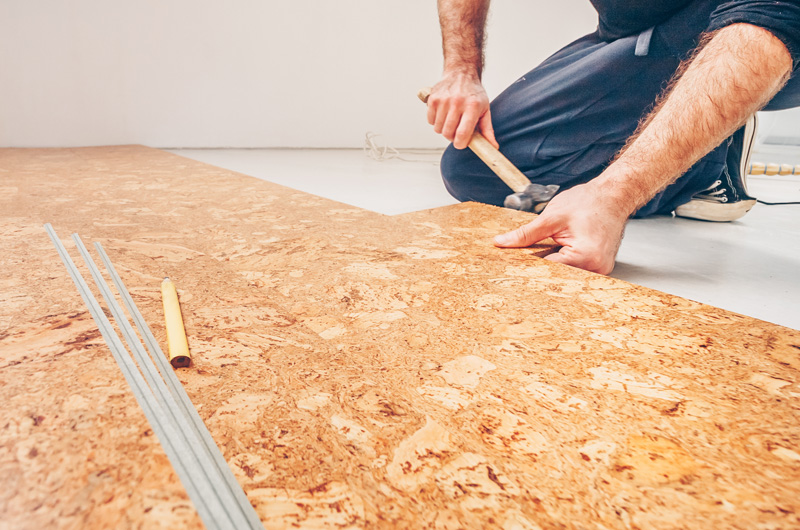Cork flooring, a timeless and eco-friendly option, has been gaining popularity for its unique qualities and aesthetic appeal. This article explores the various aspects of cork flooring, shedding light on its installation methods, place of origin, sustainability, and its eco-friendly attributes.
The glue-down method
One of the key features is its versatility in installation. Homeowners can opt to glue down cork flooring, providing a secure and durable foundation for their living spaces.
The glue-down method ensures a stable and long-lasting floor, suitable for high-traffic areas such as living rooms, kitchens, and hallways – more on this below. This installation technique not only enhances the overall performance but also contributes to its aesthetic charm.
Manufacturers Insights – authenticity is key
Interestingly, a significant portion of cork flooring is manufactured in Portugal, a country renowned for its rich cork oak forests. Portugal’s expertise in cork production has positioned it as a leading hub for high-quality.
The manufacturing process involves harvesting the outer bark of cork oak trees, a sustainable method that does not harm the tree.
Portugal’s commitment to responsible harvesting ensures the durability and authenticity of the flooring, making it a popular choice among environmentally conscious consumers.
One of the most compelling aspects of cork flooring is its sustainability.
Cork is a renewable resource, as the bark of the oak trees regenerates over time after being harvested. Unlike hardwood flooring, which requires the complete removal of trees, harvesting allows for the continuous growth and renewal of the forests.
This sustainable practice makes it an environmentally friendly choice, contributing to the preservation of natural ecosystems.
Beyond sustainability, cork flooring stands out for its eco-friendly characteristics during the production stage. The production of cork flooring involves minimal environmental impact compared to other flooring options.
The harvesting process is also non-invasive, ensuring the vitality of cork oak trees and promoting biodiversity within the forest.
Cork Structure – how it works
Cork’s eco-friendly nature extends to its performance as a flooring material.
The cellular structure of it gives it unique properties such as resilience and elasticity. This makes it inherently comfortable to walk on, providing a soft and cushioned surface underfoot.
The natural insulation properties contribute to energy efficiency by retaining heat, making it an ideal choice for homes in colder climates. As a result, cork flooring not only enhances indoor comfort but also helps reduce energy consumption, aligning with the principles of sustainability.
In terms of aesthetics, cork flooring offers a warm and inviting atmosphere to any space.
Its natural variations in colour and texture add character, creating a visually appealing floor that complements various interior styles. From contemporary to traditional, cork adapts seamlessly, offering a timeless and elegant look. The manufacturing process allows for a range of finishes, from matte to glossy, providing homeowners with the flexibility to choose a style that suits their preferences.
Beyond its visual appeal, cork flooring contributes to a healthier indoor environment. It is hypoallergenic and resistant to mould and mildew, making it an excellent choice for those with allergies or respiratory sensitivities.
The inherent properties also make it resistant to pests, further promoting a clean and hygienic living space.
Maintaining cork flooring is relatively simple, adding to its allure for homeowners seeking a low-maintenance option. Regular sweeping and occasional damp mopping are usually sufficient to keep it in top condition. Additionally, the natural properties make it resistant to stains and wear, ensuring a durable and long-lasting flooring solution.
In conclusion, cork flooring emerges as a sustainable and eco-friendly choice for homeowners looking to enhance their living spaces with a unique and environmentally conscious material. From its versatile installation options to its manufacturing roots in Portugal, cork flooring combines aesthetic appeal with responsible sourcing.
Its sustainability, eco-friendly attributes, and numerous benefits make it a flooring option that aligns with the growing demand for environmentally conscious living. As consumers increasingly prioritise sustainable choices, cork flooring stands out as a natural and elegant solution for a greener future.
Where to put it – Which Rooms and why
Beyond its intrinsic appeal and eco-friendly attributes, cork flooring is remarkably versatile, making it suitable for various rooms within a home.
Each room presents unique demands, and cork’s exceptional properties cater to diverse needs, further establishing its status as a top-tier flooring option.
One of the most popular spaces where cork flooring excels is the kitchen. The comfort underfoot provided by cork makes it an excellent choice for a room where homeowners often spend a significant amount of time standing. Its resilience to spills and stains adds to its allure, making kitchen maintenance hassle-free. The natural warmth of cork also contributes to creating a welcoming atmosphere in a space where family and friends often gather.
In the bedroom
Moving into the bedroom, cork flooring offers a cozy and comfortable surface that promotes relaxation. The cushioning effect provides a soft and supportive foundation, making it an ideal choice for bedrooms. Its insulating properties help maintain a comfortable temperature, contributing to a restful and peaceful sleeping environment. Additionally, the hypoallergenic nature of cork ensures that the bedroom remains a clean and healthy space.
In living rooms and dining areas, where style and functionality intersect, cork flooring truly shines. Its aesthetic versatility allows homeowners to choose from a range of finishes and styles that complement their interior design preferences. Whether it’s a contemporary living room or a classic dining area, you can enhance the visual appeal while offering a comfortable and durable surface for daily activities.
Cork’s acoustic properties make it a sound choice for spaces where minimising noise is crucial. Home offices or libraries, for instance, benefit from the natural sound absorption of cork, creating a quieter and more focused atmosphere. Its resilience to wear and tear also ensures that high-traffic areas remain pristine, even in spaces where foot traffic is frequent.
In Bathrooms
Bathrooms, traditionally considered challenging spaces for flooring due to high moisture levels, can also benefit from cork’s unique attributes. While it is essential to ensure proper sealing to prevent water damage, cork’s natural resistance to mould and mildew makes it a viable option for bathroom floors. Its warm and inviting surface adds a touch of luxury to these spaces, creating a spa-like ambiance.
What about playrooms?
Children’s playrooms or nurseries are another area where cork flooring stands out. Its soft and forgiving surface provides a safe and comfortable environment for little ones to play. Cork’s hypoallergenic properties are especially valuable in spaces frequented by children, contributing to a healthier indoor environment.
When considering cork flooring for basements, its resistance to moisture and mould becomes particularly advantageous. Basements, often prone to dampness, benefit from cork’s ability to withstand such conditions. Additionally, the insulation properties of cork contribute to a more comfortable basement environment, addressing both practical and aesthetic concerns.
In summary, cork flooring is a versatile and practical choice for various rooms throughout the home. From the kitchen to the bedroom, living room to the home office, the adaptability shines in diverse settings. Its comfort, durability, and aesthetic appeal make it a top contender for homeowners seeking a flooring option that not only enhances the beauty of their living spaces but also aligns with their commitment to sustainability and eco-friendliness. As the demand for environmentally conscious living continues to grow, cork flooring emerges as a timeless and practical solution for homes that prioritise both style and responsible choices.
Use a vapour barrier – not underlay
Most cork flooring doesn’t need underlay. However if you’re installing it on concrete floor, then it’s recommended to use. a vapour barrier in the form of. aplastic sheet.




